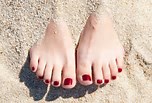



Changes in Our Skin as We Age
As we age the appearance and texture of our skin change. Blood flow decreases, which causes the skin to become drier, thunner and less elastic. The colour of the skin changes as well, and less hair grows on the lower legs and feet. The glands in our skin produce less sweat and oil. In addition, the plantar fat pad can shrink, resulting in less cushioning around the bones.
This can cause painful calluses to form on the forefoot and toes. A study in Spain found that 78% of study subjects age sixty and older had skin conditions on the feet, with calluses being the most common finding. This study alos found that more than 70% of the subjects had both skin conditions and other foot disorders, such as bunions, toenail changes, and contracted toes. Fewer than 3% had normal feet.
Some of us experience numbness or lack of feeling in our feet as we age due to a loss of nerve function called peripheral neuropathy. Loss of nerve function can make it more difficult to detect other problems with our feet, such ac calluses and blisters.Over time, this can lead to much more serious problems, including open sores and infection. Changes in the nerves as we age can also make our feet more sensitive to burning sensations and less able to regulate the temperature of our skin.
Numbness and peripheral neuropathy will be discussed in more detail in the pages on nerve conditions. For now, however, a word of caution. If you have numbness or lack of feelings in your feet, you should be extremely careful with your skin and inspect your feet daily. Do not attempt to care for your skin and toenails by yourself. Instead, seek the advice and care of a doctor - if possible, a podiatrist.
Reference:Great Feet For Life: Paul Langer DPM
